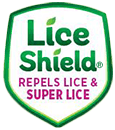Recognizing Head Lice
What is Lice?
The head louse (Latin: Pediculus humanus capitis) is a parasite inhabiting hair on the head and feeding on human blood, which it sucks from the scalp. It has 6 legs and is about 3mm long. It thrives at temperatures of 82° to 84°F, so it likes to stay close to the scalp, and often cannot be seen at a glance.
The female head louse can lay up to 10 eggs (called nits) a day, and they glue them to the hair shaft close to the roots. The nits are less than 1mm in length, and almost opaque. The larvae come out after around 8 days and a new generation is born every three weeks.
How to recognize a Lice Infestation?
The most obvious sign is a very itchy scalp, caused by the bites where the head lice suck blood. If you suspect lice infestation in your child, you should look closely and inspect the hair roots close to the scalp. A fine-toothed nit comb can be very helpful if you want to clarify whether there are lice or not. The comb helps you discover nits, which often might be mistaken for dandruff: whitish, shimmering nits are empty shrouds from which lice have already come out, while brownish-grey nits are in their development phase. Sometimes it is easier to see the bite marks on the scalp than the lice themselves. The bite marks may appear as small red pinpoints or raised dots of inflammation.
How does Lice spread?
Lice cannot fly or jump. They are normally transferred during direct contact from head to head, which is why they are frequently spread in schools and summer camps, where children work or play with their heads close together.
Recognizing Head Lice
What is Lice?
The head louse (Latin: Pediculus humanus capitis) is a parasite inhabiting hair on the head and feeding on human blood, which it sucks from the scalp. It has 6 legs and is about 3mm long. It thrives at temperatures of 82° to 84°F, so it likes to stay close to the scalp, and often cannot be seen at a glance.
The female head louse can lay up to 10 eggs (called nits) a day, and they glue them to the hair shaft close to the roots. The nits are less than 1mm in length, and almost opaque. The larvae come out after around 8 days and a new generation is born every three weeks.
How to recognize a Lice Infestation?
The most obvious sign is a very itchy scalp, caused by the bites where the head lice suck blood. If you suspect lice infestation in your child, you should look closely and inspect the hair roots close to the scalp. A fine-toothed nit comb can be very helpful if you want to clarify whether there are lice or not. The comb helps you discover nits, which often might be mistaken for dandruff: whitish, shimmering nits are empty shrouds from which lice have already come out, while brownish-grey nits are in their development phase. Sometimes it is easier to see the bite marks on the scalp than the lice themselves. The bite marks may appear as small red pinpoints or raised dots of inflammation.
How do lice spread?
Lice cannot fly or jump. They are normally transferred during direct contact from head to head, which is why they are frequently spread in schools and summer camps, where children work or play with their heads close together.
Recognizing Head Lice
What is Lice?
The head louse (Latin: Pediculus humanus capitis) is a parasite inhabiting hair on the head and feeding on human blood, which it sucks from the scalp. It has 6 legs and is about 3mm long. It thrives at temperatures of 82° to 84°F, so it likes to stay close to the scalp, and often cannot be seen at a glance.
The female head louse can lay up to 10 eggs (called nits) a day, and they glue them to the hair shaft close to the roots. The nits are less than 1mm in length, and almost opaque. The larvae come out after around 8 days and a new generation is born every three weeks.
How to recognize a Lice Infestation?
The most obvious sign is a very itchy scalp, caused by the bites where the head lice suck blood. If you suspect lice infestation in your child, you should look closely and inspect the hair roots close to the scalp. A fine-toothed nit comb can be very helpful if you want to clarify whether there are lice or not. The comb helps you discover nits, which often might be mistaken for dandruff: whitish, shimmering nits are empty shrouds from which lice have already come out, while brownish-grey nits are in their development phase. Sometimes it is easier to see the bite marks on the scalp than the lice themselves. The bite marks may appear as small red pinpoints or raised dots of inflammation.
How do lice spread?
Lice cannot fly or jump. They are normally transferred during direct contact from head to head, which is why they are frequently spread in schools and summer camps, where children work or play with their heads close together.
